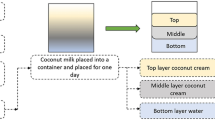Abstract
Crude oil was extracted from cottonseed by three different methods to study the influence of extraction technique on the free fatty acid (FFA) concentration. Extraction procedures that recovered more oil had higher levels of FFA. In addition, the highest concentration of FFA was found in oil recovered by Soxhlet reextraction of a meal initially defatted by a room-temperature extraction process. The FFA concentrations of oils recovered by Soxhlet extraction were highly correlated with the FFA concentration of oils recovered by the other extraction methods studied (R 2>0.96). Titration of oil and gas chromatography of silylated oil were compared as methods to determine FFA concentration. The methods compared well (R 2=0.998) with the titration method, giving ∼5% higher values for FFA than the chromatography method. Half of this difference appeared to be due to the oleic acid approximation used in the titration approach. The other half of the difference is likely due to the detection of other acidic components in crude oil.
Similar content being viewed by others
References
Trading Rules, National Cottonseed Products Association, Memphis, pp. 50–54.
Official Methods and Recommended Practices of the American Oil Chemists’ Society, 5th edn. AOCS Press, Champaign, 1998.
Wan, P.J., D.R. Pakarinen, and P.J. Wakelyn, Concerns for the Determination of Free Fatty Acid in Cottonseed, J. Am. Oil Chem. Soc. 75:1321–1324 (1998).
Wan, P.J., and D. Britton, A Collaborative Study for Free Fatty Acid Determination in Cottonseed. Technical Report submitted to the AOCS Meal and Seed and Uniform Methods Committees (1999) and INFORMS Supplement 10:S95 (1999).
Dowd, M.K., Compositional Characterization of Cottonseed Soapstocks, J. Am. Oil Chem. Soc. 73:1287–1295 (1996).
Dowd, M.K., Gas Chromatographic Characterization of Soapstocks from Vegetable Oil Refining, J. Chromatogr. A 816:185–193 (1998).
Kaiser, M.A., and F.J. Debbrecht, Qualitative and Quantitative Analysis by Gas Chromatography, in Modern Practice of Gas Chromatography, edited by R.L. Grob, John Wiley & Sons, New York, 1977.
Johansen, S.L., A. Sivasothy, M.K. Dowd, P.J. Reilly, and E.G. Hammond, Low-Molecular Weight Organic Compositions of Acid Waters from Vegetable Oil Soapstocks, J. Am. Oil Chem. Soc. 73:1275–1286 (1996).
Author information
Authors and Affiliations
Corresponding author
About this article
Cite this article
Wan, P.J., Dowd, M.K. Comparative study of the extraction and measurement of cottonseed free fatty acids. J Amer Oil Chem Soc 77, 23–27 (2000). https://doi.org/10.1007/s11746-000-0004-x
Received:
Accepted:
Issue Date:
DOI: https://doi.org/10.1007/s11746-000-0004-x




